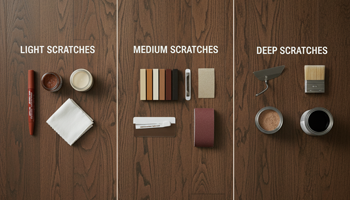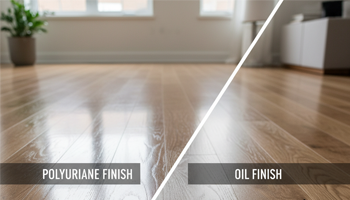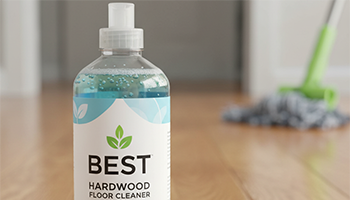Food-Safe Wood Oil for Cutting Boards & Countertops
Authoritative, practical, and battle-tested advice from a woodworker who’s finished hundreds of boards and consulted for commercial kitchens.
Why Food-Safe Matters: Understanding Oil Safety
When you oil a cutting board or butcher block, you’re literally rubbing a substance into a surface that touches raw veggies, meats, and your chef’s knife every day. That oil must be chemically inert, non-toxic, stable, and fit for repeated food contact. Here’s what that means in plain English:
FDA Regulations for Food-Contact Surfaces
“Food-safe” isn’t a vibe; it’s about using substances considered safe for repeated food contact under expected conditions of use. In practice, that’s why white mineral oil (USP/food-grade) is the industry workhorse—it’s odorless, tasteless, and doesn’t oxidize into sticky residues.
Quick distinction: Food-grade is a purity/certification standard (e.g., USP for mineral oil). Food-safe refers to suitability for contact with food under normal use. A product can be food-grade but not automatically appropriate for a wet, knife-scored board—formulation and use matter.
The Rancidity Problem with Vegetable Oils
Olive, canola, sunflower, and similar oils oxidize. Over time they polymerize and go rancid, leaving off-odors and sticky films that trap bacteria. I’ve seen a food truck nearly shut down after an inspection flagged rancid olive oil on boards—textbook violation.
Difference Between Drying and Non-Drying Oils
- Non-drying oils (mineral oil) don’t harden; they soak in and replenish the wood’s natural moisture resistance.
- Drying oils (linseed/flaxseed, tung) polymerize into a film. Many commercial versions contain metallic driers/solvents. Even when marketed as “natural,” they’re poor fits for daily-use cutting boards that are routinely re-oiled, scrubbed, and knife-scored.
Mineral Oil: The Gold Standard
What is Food-Grade Mineral Oil (USP/White Mineral Oil)
USP/white mineral oil is highly refined to strict purity standards. It’s inert, colorless, odorless, and tasteless. It won’t go rancid and won’t react with foods. Avoid hardware-store “mineral spirits”—that’s a solvent, not mineral oil.
How Mineral Oil Protects Wood
It saturates the end grain and pores, slowing water ingress and helping the surface shed spills. Think of it like a moisture “speed bump” that reduces warping and splitting while keeping fibers supple.
Application Frequency and Technique
- New board (initial seasoning): 3–4 coats.
- Between coats: Let sit 20–30 minutes; wipe off excess; allow at least 4 hours before the next coat.
- Maintenance: Monthly or whenever water stops beading.
- Pro penetration trick (what I do): Warm the board gently with a hair dryer (~100°F) before oiling. The grain opens and accepts 2–3× more oil. Most restaurants don’t know this; it dramatically improves durability.
Top Brands: Howard, Thirteen Chefs, Kate Naturals
All three offer food-grade mineral oil suitable for cutting boards and butcher block. They differ mainly in bottle size, optional additives (some lines include conditioners), and price per ounce. Choose based on availability and total cost per oz (see cost table below).
Butcher Block Oil vs Cutting Board Oil
Formulation Differences Explained
Both categories usually rely on food-grade mineral oil. “Butcher block oil” sometimes includes more conditioning waxes for large countertops; “cutting board oil” often skews lighter for easier wipe-on/wipe-off.
When to Use Each Type
- Countertops: Prefer oils or conditioners with wax (beeswax/carnauba) to improve water repellency and reduce daily splash absorption.
- Portable cutting boards: Straight mineral oil or oil + a light board cream top-coat.
Can You Interchange Them?
Yes, within reason. The key is the ingredients: stick to USP mineral oil, optionally beeswax/carnauba. Avoid products with dryers, varnish resins, or solvents.
Walrus Oil and Premium Brands
Walrus Oil Cutting Board Oil Review
Applies smoothly, pleasant finish, and often highlighted for third-party certifications useful in commercial settings. Performance on home boards is excellent—but comparable to standard USP mineral oil in real-world food-prep use.
Boos Block Mystery Oil Analysis
A long-trusted staple from a butcher-block manufacturer; essentially mineral oil-based. Pair it with a board cream if you want extra water beading.
Are Premium Oils Worth the Extra Cost?
For residential users, my experience says no—you’re paying a brand and packaging premium. For commercial kitchens under strict compliance, premium SKUs with explicit certifications can be worth it to satisfy inspectors and SOPs.
Beeswax and Combination Products
Benefits of Beeswax Additions
Beeswax reduces water absorption, improves water beading, and adds a pleasant satin look. It also slows how fast liquids soak in after a spill.
Carnauba Wax in Wood Conditioners
Carnauba (plant-based) is harder and glossier than beeswax. In small percentages, it boosts scuff resistance on high-traffic countertops.
DIY Beeswax and Oil Mixture Recipe
My go-to formula: 3 parts USP mineral oil + 1 part melted beeswax.
- Melt beeswax gently (double boiler), blend into warm mineral oil, cool to a soft balm.
- Apply like a board cream after oiling.
Board Cream vs Straight Oil
- Straight oil: Best for deep saturation.
- Board cream (oil + wax): Best as a final top-coat to enhance repellency and feel. I oil first, then cream.
Coconut Oil: Natural Alternative
Pros and Cons of Fractionated Coconut Oil
Fractionated coconut oil resists rancidity better than regular coconut oil and stays liquid. It can work—but it’s still not as oxidation-resistant as mineral oil for long maintenance intervals.
Rancidity Risk Assessment
Any triglyceride oil risks oxidation over time. If you insist on coconut, use fractionated only and monitor odor/feel. Discontinue at the first sign of tackiness or off-smell.
Best Use Cases for Coconut Oil
Occasional touch-ups on personal boards, especially if you prefer plant-derived options. For heavy daily use, mineral oil remains the safer bet.
Oils to NEVER Use on Cutting Boards
Olive Oil and Vegetable Oil (Why They Go Rancid)
They oxidize, gum up, and smell. They also trap debris—hard pass.
Linseed and Tung Oil (Not Food-Safe Despite Claims)
Raw or “boiled” linseed products and many tung formulations contain metallic driers/solvents and can trigger allergies. Even “pure” drying oils require long cure windows and don’t suit boards that are continually re-oiled and washed. For daily-use, knife-scored surfaces, avoid them.
Motor Oil and “Mineral Spirits” Confusion
- Motor oil: Absolutely not.
- Mineral spirits: A petroleum solvent, not the same as mineral oil. Do not put it on food surfaces.
⚠️ Call-Out Warning: Some “all-natural board oils” quietly include tung oil. If you have nut allergies in the household or your kitchen serves the public, avoid anything with tung or ambiguous “plant polymer” ingredients.
Application Methods and Techniques
Initial Seasoning: 3–4 Coat Process
- Clean and dry the wood (fully dry).
- Warm the surface with a hair dryer (~100°F).
- Flood with USP mineral oil; let sit 20–30 minutes.
- Wipe off puddles; repeat 3–4 times with at least 4 hours between coats.
- Optional: finish with board cream (thin coat, buff after 20 minutes).
Maintenance Schedule (Monthly vs As-Needed)
- Monthly is a good baseline.
- Or re-oil whenever water stops beading or the surface looks gray/dry.
Proper Absorption Time
Give each coat 20–30 minutes to penetrate. Overnight dry after the final coat is ideal.
Removing Excess Oil
Finish by buffing dry with a lint-free towel. No visible sheen or wet spots should remain.
Butcher Block Countertop Specific Care
Higher Volume Oil Requirements
Countertops soak much more oil than boards. Expect to use several ounces during initial seasoning and regular top-ups in wet zones (around sinks).
Integration with Kitchen Workflow
Block off a seasoning day after installation or deep cleaning. Oil in the evening; buff in the morning before service.
Protecting Against Daily Spills
Use board cream/oil-wax blends in splash zones; keep microfiber towels handy. Wipe spills immediately; re-cream weekly near sinks.
Troubleshooting Common Issues
Oil Not Absorbing (Wood Too Saturated)
If the surface still looks wet after 30 minutes, it’s topped out. Buff dry and extend the time between maintenance coats. If the board feels greasy, wash with mild dish soap, dry thoroughly, then resume normal schedule.
Sticky Residue Problems
Usually caused by over-application or wax build-up. Warm gently with a hair dryer and buff hard. If needed, wipe lightly with fresh mineral oil and buff again to even it out.
Dealing with Rancid Oil Smell
Scrub with hot water + mild dish soap, sprinkle coarse salt, rub with a cut lemon, rinse, and fully dry upright. Re-season with USP mineral oil only.
Food-safe oil selection belongs inside the broader context of Interior Wood Care, while water ring removal methods are outlined in Remove Water Stains from Wood Furniture.
Currently viewing
Food-Safe Wood Oil

Repair Scratches in Hardwood Floors
How to Repair Scratches in Hardwood Floors: Complete Guide by Severity Level If you’re staring…
Refinishing Hardwood Floors
Sand & Refinish vs Screen & Recoat — Complete Comparison Guide If you’re weighing screen…
Polyurethane vs Oil Finish Floors
Durability & Maintenance Comparison If you’re comparing polyurethane vs oil finish for hardwood floors, you’re…
Best Hardwood Floor Cleaner
pH-Neutral & No-Residue Options TL;DR (buyer’s snapshot): For most homes, a pH-neutral hardwood floor cleaner…
Hardwood Floor Care Masterclass
Complete Guide by Wood Species & Finish If you want hardwood floor care by species…
Cost Comparison Table
Assumptions for “treatments per bottle”: 1 oz per maintenance treatment; initial seasoning uses 3–4 oz total on a typical 12”×18” board. Prices vary by retailer—use the $/oz math below to compare.
| Product / Oil | Bottle Size (oz) | Example Price (USD) | $/oz (Exact Math) | Maintenance Treatments / Bottle | Cost per Maintenance Treatment | Initial Seasonings / Bottle (3–4 oz) |
|---|---|---|---|---|---|---|
| Howard Cutting Board Oil | 12 | $8 | $0.67 (8÷12) | ~12 | ~$0.67 | ~3–4 |
| Walrus Oil Cutting Board Oil | 8 | $25 | $3.13 (25÷8) | ~8 | ~$3.13 | ~2 |
| Thirteen Chefs Mineral Oil | 12 | $9–$12 | $0.75–$1.00 | ~12 | ~$0.75–$1.00 | ~3–4 |
| Kate Naturals Mineral Oil | 16 | $10–$14 | $0.63–$0.88 | ~16 | ~$0.63–$0.88 | ~4–5 |
| DIY 3:1 Oil+Beeswax (my blend) | — | ≈$3 per new board (4 coats) | — | — | ≈$0.75 per coat | 1 full seasoning for ≈$3 |
Takeaway: For most home kitchens, Howard/Thirteen Chefs/Kate Naturals deliver nearly identical performance to premium oils at a fraction of the $/oz. Use a wax top-coat when you need more water beading.
FAQs
Is “food-grade” the same as “food-safe”?
No. Food-grade is a purity/certification standard. Food-safe means appropriate for repeated food contact under real use. An ingredient can be food-grade and still not be the right choice for a wet, knife-scored board.
How often should I oil my cutting board?
Monthly is a good baseline. Re-oil anytime water stops beading or the surface looks dry.
Can I use olive oil or vegetable oil?
No. They oxidize and go rancid, creating odors and sticky films.
Is fractionated coconut oil okay?
It can work in a pinch, but mineral oil is more oxidation-resistant and lower maintenance.
Why is my board still greasy the next morning?
You likely over-applied or the wood is saturated. Buff vigorously and extend the time between re-oils.
What is the best food-safe oil for wooden cutting boards?
USP/food-grade mineral oil. It’s stable, inert, won’t go rancid, and is easy to refresh. For extra water resistance, finish with a thin beeswax/carnauba cream.
How to season a new butcher block countertop with oil
Clean and dry → warm surface → flood with mineral oil → wait 30 minutes → wipe → repeat 3–4 coats with a few hours between → finish with a wax-conditioner in splash zones → let cure overnight before heavy use.
Mineral oil vs Walrus Oil for cutting boards
Performance on home boards is effectively the same. Walrus (and similar premium SKUs) may add certification value for commercial settings; for residential, a good USP mineral oil wins on cost per ounce.
Food-safe wood conditioner for butcher block
Use an oil + beeswax/carnauba conditioner after mineral oil. It improves beading, slows stain penetration, and looks fantastic on countertops.
How to remove sticky residue from cutting board oil
Warm lightly with a hair dryer, buff with a clean towel. If still tacky, wipe a small amount of fresh mineral oil to mobilize residue, then buff dry. Reduce wax load next time.
For cutting boards and butcher block countertops in 2025, USP/food-grade mineral oil remains the most reliable, affordable, and inspection-friendly choice. Add a light wax conditioner for countertops or high-splash areas. Avoid vegetable oils and drying-oil finishes that introduce rancidity, allergens, or curing complications. If you want top performance at bottom cost, the DIY 3:1 mineral oil + beeswax blend (what I give with my custom boards) still beats most pricey bottles—and costs about $3 per full seasoning.





